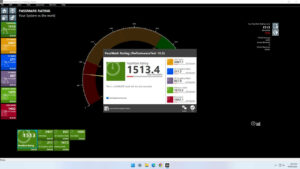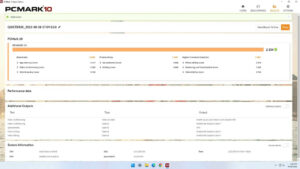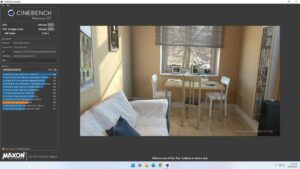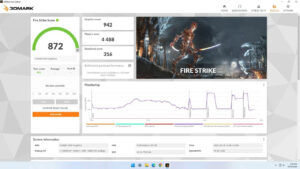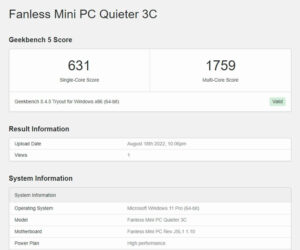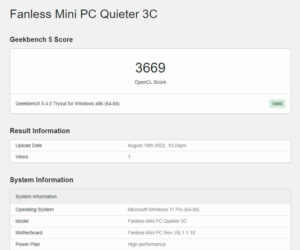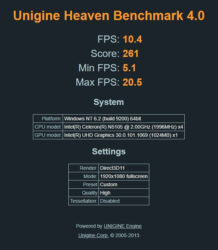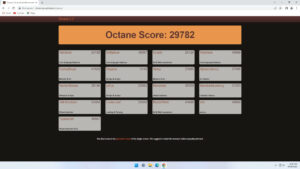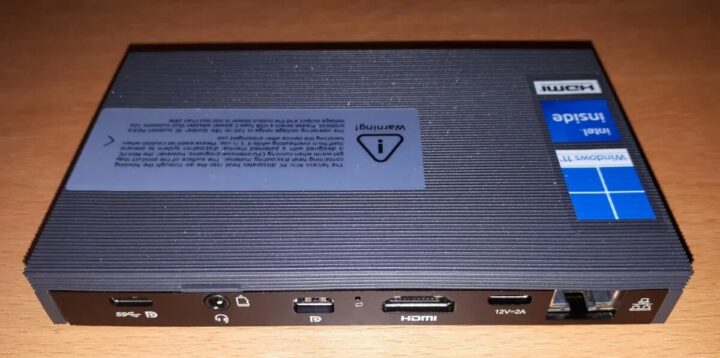
MeLE 不久前新推出了 Quieter3C 迷你 PC,该迷你 PC 其实是之前产品Quieter3Q 的更新升级,此次的 Quieter3C 将其中一个 Type-A USB 端口替换为了 Type-C USB 端口,使其能够供电和进行视频显示输出。另外,他们还将其中一个 HDMI 端口更改为了 mini DP。MeLE 寄了一个样品给我进行评测。由于他们此次的改动不多,产品的性能基准我就大致看一下,然后查看一下新功能。
MeLE Quieter3C 的硬件情况
MeLE Quieter3C 的物理尺寸跟 Quieter3Q 相同,它带有一个131 x 81 x 18.3 mm(5.16 x 3.19 x 0.72 英寸)的矩形塑料外壳和金属底板。外壳的上半部分具有特征性的细凹槽、模仿散热器的鳍片(Fin)。外壳是由塑料制成的而并非常见的金属,这样迷你 PC 直接连到 WiFi 天线时就方便接收 WiFi 信号。作为一款被动散热的迷你电脑,Quieter3C 使用了英特尔 10 纳米 Jasper Lake N5105 处理器,这是一款四核 4 线程 2.00 GHz Celeron 处理器,睿频2.90 GHz,搭载英特尔的 UHD Graphics。
MeLE Quieter3C 的前面板只有一个发光的电源按钮;后面板则包括了一个 Type-C USB 端口、一个耳机插孔、一个 microSD 卡插槽、一个 mini DisplayPort、一个 HDMI 端口、一个仅用于供电的 Type-C USB 端口,以及一个千兆以太网端口;左侧面板有一个 Kensington 安全插槽;右侧面板跟 Quieter3Q 一样还是带有三个 Type-A USB 端口。
此次我评测的 Quieter3C 型号包括一个板焊 128GB eMMC 硬盘和一个板焊 8GB LPDDR4 3200 MHz 单通道内存,其频率为 2933 MHz:
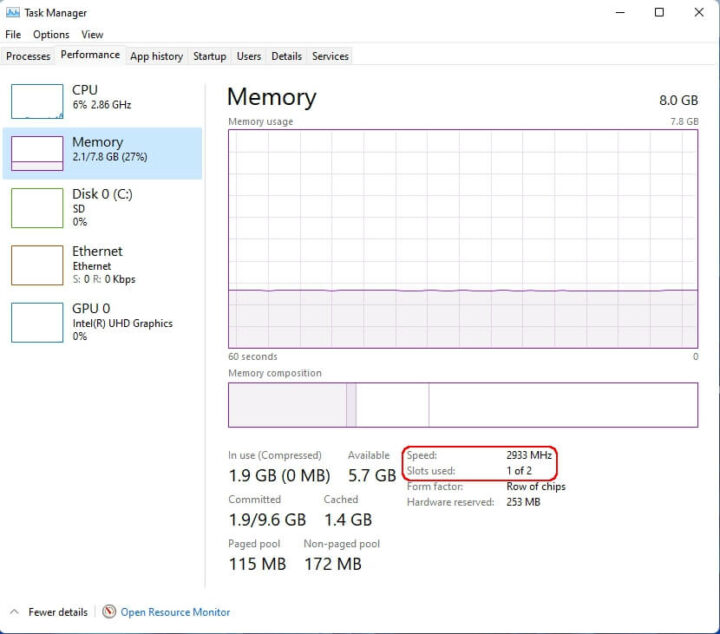
该迷你 PC 还有一个板焊 WiFi 6(或 802.11ax)英特尔 AX201 卡,以及添加 M.2 2280 NVMe SSD 硬盘的能力。
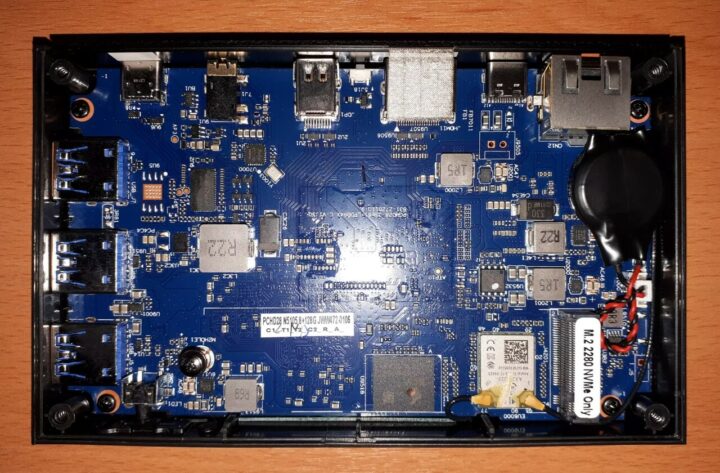
MeLE Quieter3C 的规格说明:

MeLE 此次将所有的 USB 端口都列为了 3.0,因此我决定使用 USB Type-C 来将这些 USB 端口都测试一下。我使用了安装在一块“USB 到 M.2 NVMe 适配器”(ORICO M2PAC3-G20 M.2 NVMe SSD Enclosure)中的三星 980Pro PCIe 4.0 NVME SSD 来测试,结果显示右侧的前两个 USB 端口实际上是“USB 3.1”(USB 3.2 Gen 2×1 即 10 Gbit/s):
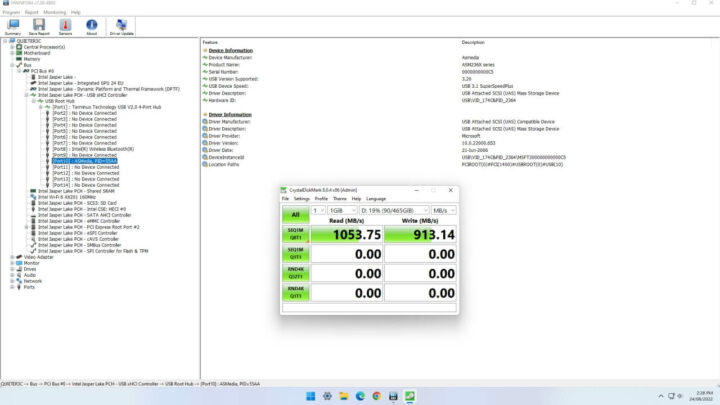
测试结果显示,Quieter3C 只有第三个端口和后置 Type-C USB 端口是“USB 3.0”(USB 3.2 Gen 1×1 即 5 Gbit/s):
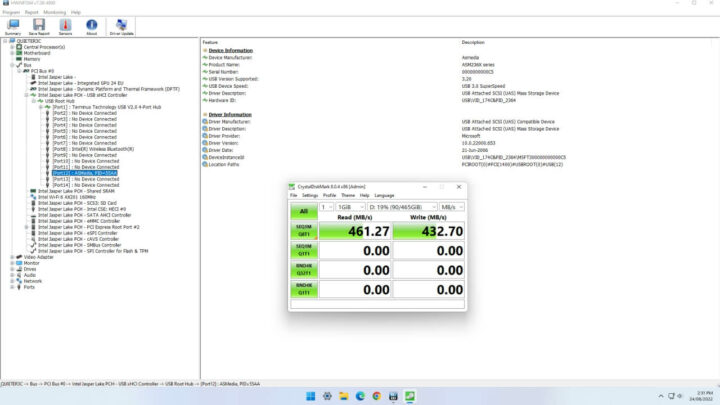
该型号的新 Type-C USB 端口还可以通过“交替模式”输出视频:

与 mini DisplayPort 一起:

剩下的 HDMI 端口现在可以支持三重 4K 显示器。
我还确认了一下新的 Type-C USB 端口可以通过“将 MeLE Quieter3C 直接连接到戴尔显示器”从而无需再单独连接电源来支持供电:
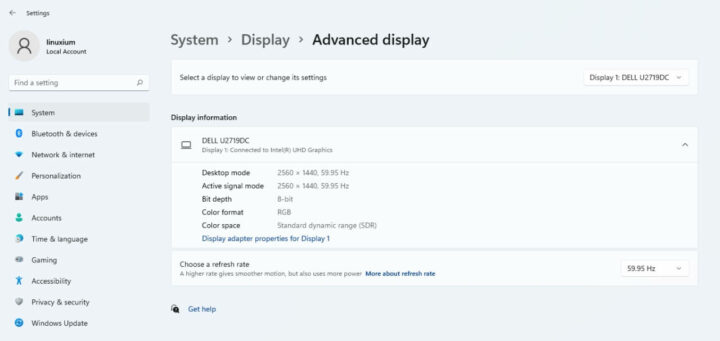
MeLE Quieter3C盒内物品
在包装盒中,用户可以得到一个电源适配器、电源线、所在国家和地区的插头适配器、快速入门指南、用于 M.2 硬盘的导热垫、可选的 VESA 安装支架,以及一小包其他各种螺钉:
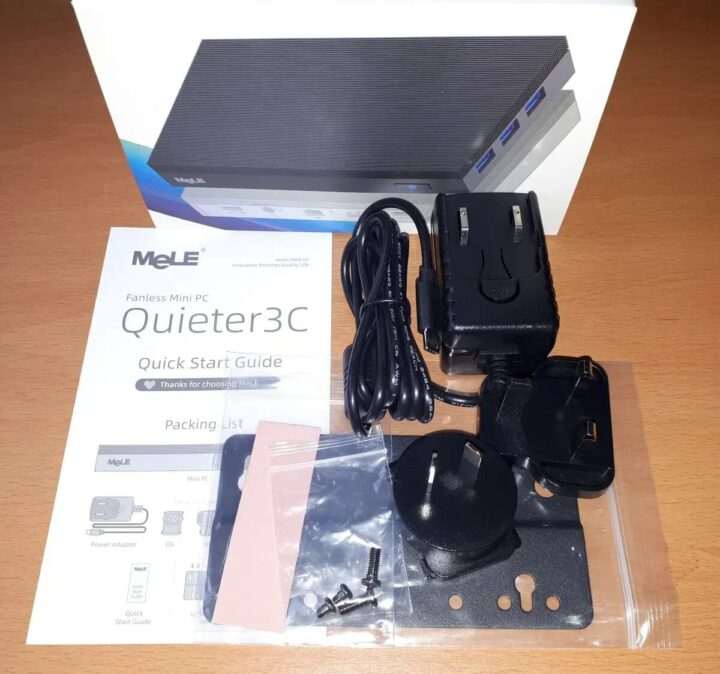
评测方法
在评测迷你 PC 时,我通常都会先查看它们在 Windows 和 Linux (Ubuntu) 下的性能,然后再将它们与最近发布的一些迷你 PC 进行比较。我现在使用 Windows 11 版本 21H2 和 Ubuntu 22.04.1 LTS 来评测 MeLE Quieter3C,接着会使用一系列常用的 Windows 基准测试和 Linux 等效测试再进行测试。
在进行基准测试之前,我会将各种操作更新到最新版本。我也会为每个操作系统设备截一些图。
安装问题
启动 Ubuntu 22.04.1 时,“dmesg”中报告了常见的 UEFI (BIOS) 错误,这在 Jasper Lake 迷你 PC 中是很常见。不过我暂时不清楚这个错误的重要性:
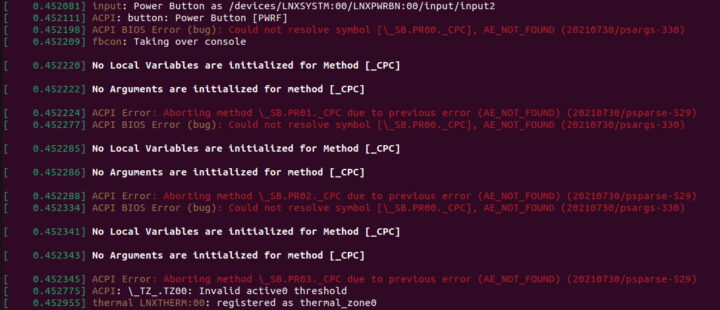
Windows 11 在 MeLE Quieter3C 上的性能
MeLE Quieter3C 安装好 Windows 11 Pro 版本 21H2 的许可副本,应用更新后变成了 build 22000.856。快速查看硬件信息可以看出是符合规范的:
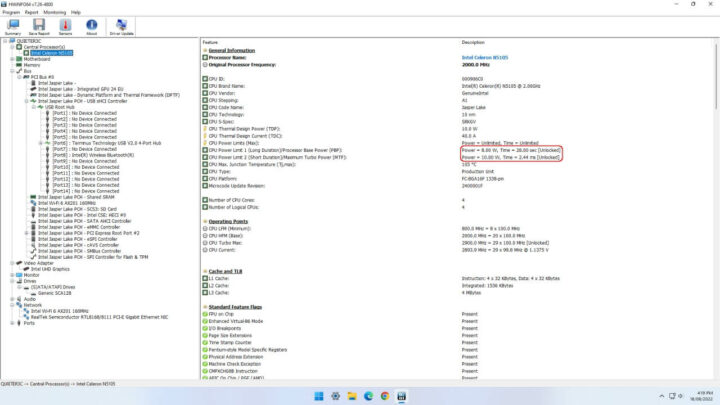
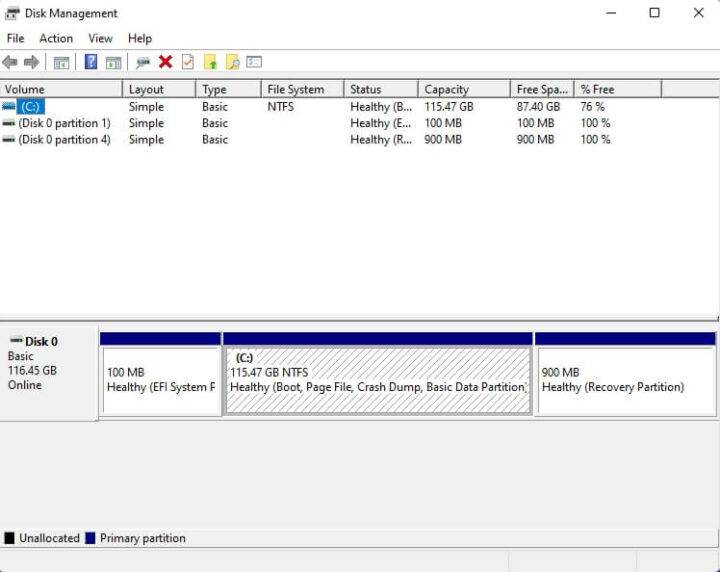
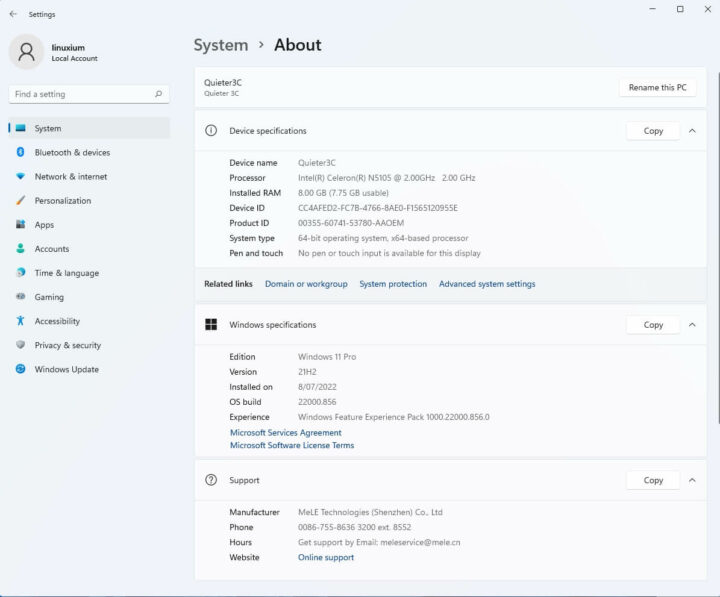
与其他 Jasper Lake 迷你 PC 类似,其 iGPU 在 HWiNFO 中显示的细节也有限,GPU-Z 则无法显示具体型号:
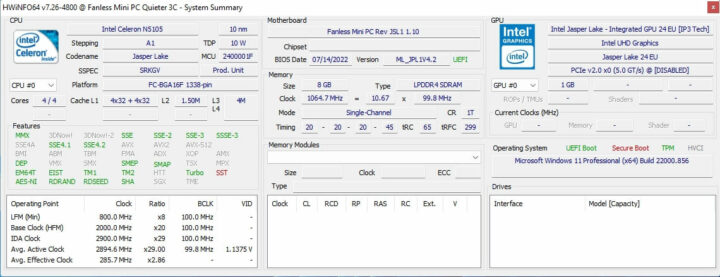
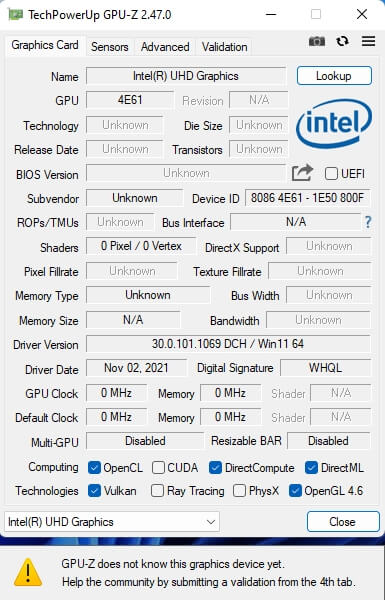
简单的检查 MeLE Quieter3C 可以看到音频、Wi-Fi、蓝牙、以太网、迷你 DP、HDMI 和 micro-SD 卡都是工作正常的,如下所示:
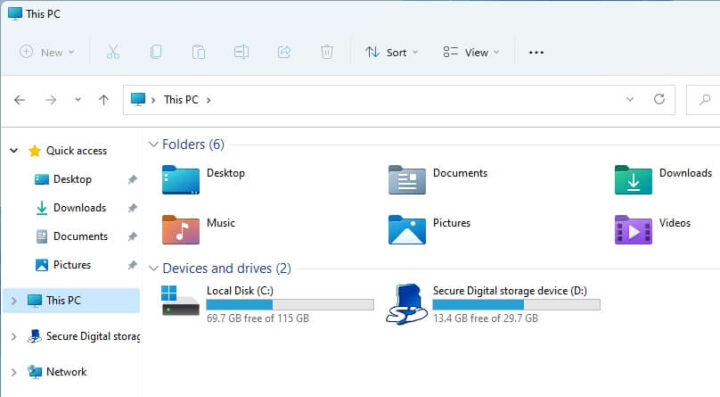
现在我将电源模式设置为“高性能”,并运行标准基准测试工具集来查看 Windows 下的各项性能:
我还测试了一下 Cinebench R23:
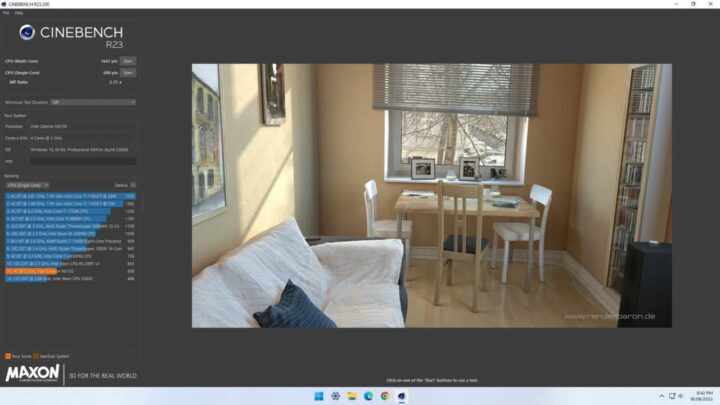
现在我将 MeLE Quieter3C 测试得到的结果与最近推出的一些其他迷你 PC 进行比较:

由上表可以看出 Quieter3C 的性能与 Quieter3Q 非常相似。
Ubuntu 22.04 的性能
在将 Windows 分区缩小一半并创建一个新分区后,我在电脑上使用 Ubuntu 22.04.1 ISO 安装了双系统。安装和更新后,我简单查看了一下音频、Wi-Fi、蓝牙、以太网、迷你 DP、HDMI 和 microSD 卡,一切都是正常运行的:
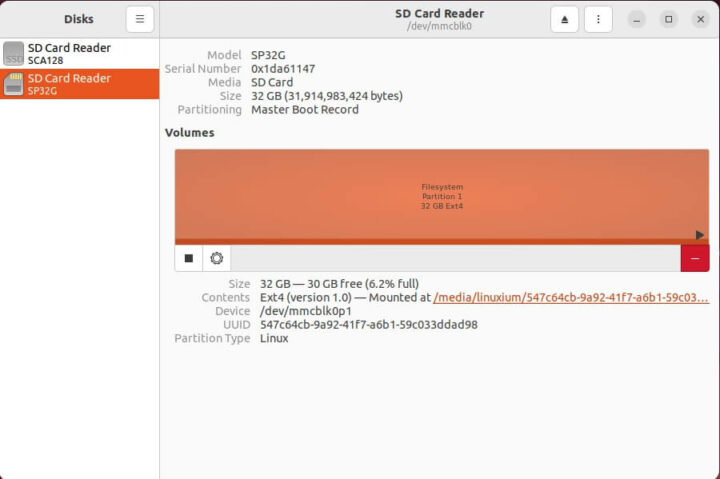
Ubuntu 22.04.1 下的关键硬件信息如下所示:
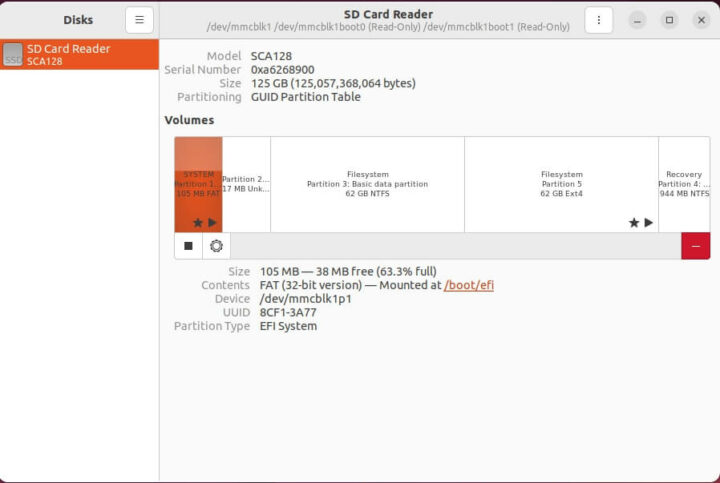
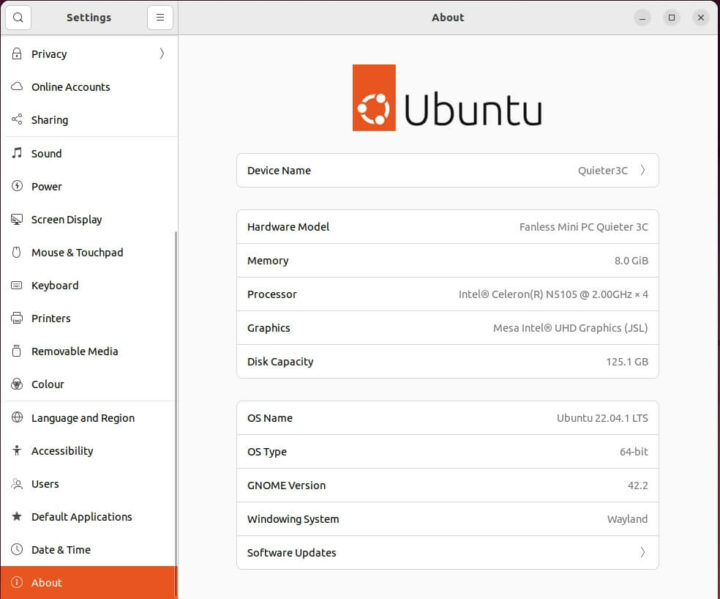
|
1 2 3 4 5 6 7 8 9 10 11 12 13 14 15 16 17 18 19 20 21 22 23 24 25 26 27 28 29 30 31 32 33 34 35 36 37 38 39 40 41 42 43 44 45 46 47 48 49 50 51 52 53 54 55 56 57 58 59 60 61 62 63 64 65 66 67 68 69 70 71 72 73 74 75 76 77 78 79 80 81 82 83 84 85 86 87 88 89 90 91 92 93 94 95 96 97 98 99 100 101 102 103 104 105 106 107 108 109 110 111 112 113 114 115 116 117 118 119 120 121 122 123 124 125 126 127 128 129 130 131 132 133 134 135 136 137 138 139 140 141 142 143 144 145 146 147 148 149 150 151 152 153 154 155 156 157 158 159 160 161 162 163 164 165 166 167 168 169 170 171 172 173 174 175 176 177 178 179 180 181 182 183 184 185 186 187 188 189 190 191 192 193 194 195 196 197 198 199 200 201 202 203 204 205 206 207 208 209 210 211 212 213 214 215 216 217 218 219 220 221 222 223 224 225 226 227 228 229 230 231 232 233 234 235 236 237 238 239 240 241 242 243 244 245 246 247 248 249 250 |
linuxium@Quieter3C:~$ lsb_release -a Distributor ID: Ubuntu Description: Ubuntu 22.04.1 LTS Release: 22.04 Codename: jammy linuxium@Quieter3C:~$ linuxium@Quieter3C:~$ uname -a Linux Quieter3C 5.15.0-46-generic #49-Ubuntu SMP Thu Aug 4 18:03:25 UTC 2022 x86_64 x86_64 x86_64 GNU/Linux linuxium@Quieter3C:~$ linuxium@Quieter3C:~$ inxi -Fzc0y-1 System: Kernel: 5.15.0-46-generic x86_64 bits: 64 Console: pty pts/1 Distro: Ubuntu 22.04.1 LTS (Jammy Jellyfish) Machine: Type: Mini-pc System: Fanless Mini PC product: Quieter 3C v: N/A serial: <filter> Mobo: Fanless Mini PC model: Rev JSL1 1.10 serial: <filter> UEFI: American Megatrends LLC. v: ML_JPL1V4.2 date: 07/14/2022 CPU: Info: quad core model: Intel Celeron N5105 bits: 64 type: MCP cache: L2: 1.5 MiB Speed (MHz): avg: 2361 min/max: 800/2900 cores: 1: 2783 2: 1615 3: 2870 4: 2179 Graphics: Device-1: Intel JasperLake [UHD Graphics] driver: i915 v: kernel Display: server: X.Org v: 1.22.1.1 driver: gpu: i915 note: X driver n/a resolution: 1920x1080~60Hz OpenGL: renderer: Mesa Intel UHD Graphics (JSL) v: 4.6 Mesa 22.0.5 Audio: Device-1: Intel driver: snd_hda_intel Sound Server-1: ALSA v: k5.15.0-46-generic running: yes Sound Server-2: PulseAudio v: 15.99.1 running: yes Sound Server-3: PipeWire v: 0.3.48 running: yes Network: Device-1: Intel Wi-Fi 6 AX201 160MHz driver: iwlwifi IF: wlp0s20f3 state: down mac: <filter> Device-2: Realtek RTL8111/8168/8411 PCI Express Gigabit Ethernet driver: r8169 IF: enp1s0 state: up speed: 1000 Mbps duplex: full mac: <filter> Bluetooth: Device-1: Intel AX201 Bluetooth type: USB driver: btusb Report: hciconfig ID: hci0 state: up address: <filter> bt-v: 3.0 Drives: Local Storage: total: 116.47 GiB used: 9.21 GiB (7.9%) ID-1: /dev/mmcblk1 model: SCA128 size: 116.47 GiB Partition: ID-1: / size: 56.53 GiB used: 9.15 GiB (16.2%) fs: ext4 dev: /dev/mmcblk1p5 ID-2: /boot/efi size: 96 MiB used: 59.3 MiB (61.8%) fs: vfat dev: /dev/mmcblk1p1 Swap: Alert: No swap data was found. Sensors: System Temperatures: cpu: 27.8 C mobo: N/A Fan Speeds (RPM): N/A Info: Processes: 225 Uptime: 12m Memory: 7.52 GiB used: 1.38 GiB (18.4%) Shell: new-review-test inxi: 3.3.13 linuxium@Quieter3C:~$ linuxium@Quieter3C:~$ df -h Filesystem Size Used Avail Use% Mounted on tmpfs 770M 2.0M 768M 1% /run /dev/mmcblk1p5 57G 9.2G 45G 18% / tmpfs 3.8G 0 3.8G 0% /dev/shm tmpfs 5.0M 4.0K 5.0M 1% /run/lock /dev/mmcblk1p1 96M 60M 37M 62% /boot/efi tmpfs 770M 2.5M 768M 1% /run/user/1000 linuxium@Quieter3C:~$ linuxium@Quieter3C:~$ lsblk -a NAME MAJ:MIN RM SIZE RO TYPE MOUNTPOINTS loop0 7:0 0 4K 1 loop /snap/bare/5 loop1 7:1 0 62M 1 loop /snap/core20/1587 loop2 7:2 0 400.8M 1 loop /snap/gnome-3-38-2004/112 loop3 7:3 0 284K 1 loop /snap/snapd-desktop-integration/14 loop4 7:4 0 91.7M 1 loop /snap/gtk-common-themes/1535 loop5 7:5 0 163.3M 1 loop /snap/firefox/1635 loop6 7:6 0 47M 1 loop /snap/snapd/16292 loop7 7:7 0 45.9M 1 loop /snap/snap-store/582 loop8 7:8 0 0B 0 loop mmcblk1 179:0 0 116.5G 0 disk ├─mmcblk1p1 179:1 0 100M 0 part /boot/efi ├─mmcblk1p2 179:2 0 16M 0 part ├─mmcblk1p3 179:3 0 57.7G 0 part ├─mmcblk1p4 179:4 0 900M 0 part └─mmcblk1p5 179:5 0 57.7G 0 part / mmcblk1boot0 179:8 0 4M 1 disk mmcblk1boot1 179:16 0 4M 1 disk linuxium@Quieter3C:~$ linuxium@Quieter3C:~$ sudo lshw -C cpu *-cpu description: CPU product: Intel(R) Celeron(R) N5105 @ 2.00GHz vendor: Intel Corp. physical id: b bus info: cpu@0 version: 6.156.0 serial: <filter> slot: U3E1 size: 2897MHz capacity: 2900MHz width: 64 bits clock: 100MHz capabilities: lm fpu fpu_exception wp vme de pse tsc msr pae mce cx8 apic sep mtrr pge mca cmov pat pse36 clflush dts acpi mmx fxsr sse sse2 ss ht tm pbe syscall nx rdtscp x86-64 constant_tsc art arch_perfmon pebs bts rep_good nopl xtopology nonstop_tsc cpuid aperfmperf tsc_known_freq pni pclmulqdq dtes64 monitor ds_cpl vmx est tm2 ssse3 sdbg cx16 xtpr pdcm sse4_1 sse4_2 x2apic movbe popcnt tsc_deadline_timer aes xsave rdrand lahf_lm 3dnowprefetch cpuid_fault epb cat_l2 cdp_l2 ssbd ibrs ibpb stibp ibrs_enhanced tpr_shadow vnmi flexpriority ept vpid ept_ad fsgsbase tsc_adjust smep erms rdt_a rdseed smap clflushopt clwb intel_pt sha_ni xsaveopt xsavec xgetbv1 xsaves split_lock_detect dtherm ida arat pln pts hwp hwp_notify hwp_act_window hwp_epp hwp_pkg_req umip waitpkg gfni rdpid movdiri movdir64b md_clear flush_l1d arch_capabilities cpufreq configuration: cores=4 enabledcores=4 microcode=603979811 threads=4 linuxium@Quieter3C:~$ linuxium@Quieter3C:~$ sudo lshw -C memory *-firmware description: BIOS vendor: American Megatrends International, LLC. physical id: 0 version: ML_JPL1V4.2 date: 07/14/2022 size: 64KiB capacity: 8MiB capabilities: pci upgrade shadowing cdboot bootselect socketedrom edd int13floppy1200 int13floppy720 int13floppy2880 int5printscreen int14serial int17printer acpi usb biosbootspecification uefi *-memory description: System Memory physical id: 4 slot: System board or motherboard size: 8GiB *-bank:0 description: Row of chips LPDDR4 Synchronous 3200 MHz (0.3 ns) vendor: SK Hynix physical id: 0 serial: <filter> slot: Controller0-ChannelA size: 8GiB width: 32 bits clock: 3200MHz (0.3ns) *-bank:1 description: Project-Id-Version: lshwReport-Msgid-Bugs-To: FULL NAME <EMAIL@ADDRESS>PO-Revision-Date: 2012-02-02 13:04+0000Last-Translator: Joel Addison <jaddi27@gmail.com>Language-Team: English (Australia) <en_AU@li.org>MIME-Version: 1.0Content-Type: text/plain; charset=UTF-8Content-Transfer-Encoding: 8bitX-Launchpad-Export-Date: 2022-07-21 13:07+0000X-Generator: Launchpad (build 025a39fd866a641b6ae33074cda0d02a2c712d38)Project-Id-Version: lshwReport-Msgid-Bugs-To: FULL NAME <EMAIL@ADDRESS>PO-Revision-Date: 2012-02-02 13:04+0000Last-Translator: Joel Addison <jaddi27@gmail.com>Language-Team: English (Australia) <en_AU@li.org>MIME-Version: 1.0Content-Type: text/plain; charset=UTF-8Content-Transfer-Encoding: 8bitX-Launchpad-Export-Date: 2022-07-21 13:07+0000X-Generator: Launchpad (build 025a39fd866a641b6ae33074cda0d02a2c712d38) [empty] physical id: 1 slot: Controller0-ChannelB-DIMM0 *-cache:0 description: L1 cache physical id: 8 slot: L1 Cache size: 256KiB capacity: 256KiB capabilities: synchronous internal write-back configuration: level=1 *-cache:1 description: L2 cache physical id: 9 slot: L2 Cache size: 1536KiB capacity: 1536KiB capabilities: synchronous internal write-back unified configuration: level=2 *-cache:2 description: L3 cache physical id: a slot: L3 Cache size: 4MiB capacity: 4MiB capabilities: synchronous internal write-back unified configuration: level=3 *-memory UNCLAIMED description: RAM memory product: Intel Corporation vendor: Intel Corporation physical id: 14.2 bus info: pci@0000:00:14.2 version: 01 width: 64 bits clock: 33MHz (30.3ns) capabilities: pm cap_list configuration: latency=0 resources: iomemory:600-5ff iomemory:600-5ff memory:6001128000-6001129fff memory:600112e000-600112efff linuxium@Quieter3C:~$ linuxium@Quieter3C:~$ free -mh total used free shared buff/cache available Mem: 7.5Gi 790Mi 2.4Gi 303Mi 4.3Gi 6.2Gi Swap: 0B 0B 0B linuxium@Quieter3C:~$ linuxium@Quieter3C:~$ sudo lshw -C network *-network description: Wireless interface product: Wi-Fi 6 AX201 160MHz vendor: Intel Corporation physical id: 14.3 bus info: pci@0000:00:14.3 logical name: wlp0s20f3 version: 01 serial: <filter> width: 64 bits clock: 33MHz capabilities: pm msi pciexpress msix bus_master cap_list ethernet physical wireless configuration: broadcast=yes driver=iwlwifi driverversion=5.15.0-46-generic firmware=66.f1c864e0.0 QuZ-a0-hr-b0-66.u latency=0 link=no multicast=yes wireless=IEEE 802.11 resources: iomemory:600-5ff irq:16 memory:6001124000-6001127fff *-network description: Ethernet interface product: RTL8111/8168/8411 PCI Express Gigabit Ethernet Controller vendor: Realtek Semiconductor Co., Ltd. physical id: 0 bus info: pci@0000:01:00.0 logical name: enp1s0 version: 15 serial: <filter> size: 1Gbit/s capacity: 1Gbit/s width: 64 bits clock: 33MHz capabilities: pm msi pciexpress msix bus_master cap_list ethernet physical tp mii 10bt 10bt-fd 100bt 100bt-fd 1000bt-fd autonegotiation configuration: autonegotiation=on broadcast=yes driver=r8169 driverversion=5.15.0-46-generic duplex=full firmware=rtl8168h-2_0.0.2 02/26/15 ip=<filter> latency=0 link=yes multicast=yes port=twisted pair speed=1Gbit/s resources: irq:17 ioport:3000(size=256) memory:7fc04000-7fc04fff memory:7fc00000-7fc03fff linuxium@Quieter3C:~$ linuxium@Quieter3C:~$ sudo lshw -C display *-display description: VGA compatible controller product: JasperLake [UHD Graphics] vendor: Intel Corporation physical id: 2 bus info: pci@0000:00:02.0 logical name: /dev/fb0 version: 01 width: 64 bits clock: 33MHz capabilities: pciexpress msi pm vga_controller bus_master cap_list rom fb configuration: depth=32 driver=i915 latency=0 mode=2560x1080 resolution=2560,1080 visual=truecolor xres=2560 yres=1080 resources: iomemory:600-5ff iomemory:400-3ff irq:135 memory:6000000000-6000ffffff memory:4000000000-400fffffff ioport:4000(size=64) memory:c0000-dffff linuxium@Quieter3C:~$ linuxium@Quieter3C:~$ dmesg | grep "MMC card" [ 1.213211] mmc1: new HS400 Enhanced strobe MMC card at address 0001 linuxium@Quieter3C:~$ linuxium@Quieter3C:~$ dmesg | egrep -i sdhci\|mmc [ 0.179572] PCI: MMCONFIG for domain 0000 [bus 00-ff] at [mem 0xc0000000-0xcfffffff] (base 0xc0000000) [ 0.179572] PCI: MMCONFIG at [mem 0xc0000000-0xcfffffff] reserved in E820 [ 1.067555] sdhci: Secure Digital Host Controller Interface driver [ 1.067560] sdhci: Copyright(c) Pierre Ossman [ 1.071347] sdhci-pci 0000:00:14.5: SDHCI controller found [8086:4df8] (rev 1) [ 1.083529] mmc0: SDHCI controller on PCI [0000:00:14.5] using ADMA 64-bit [ 1.083588] sdhci-pci 0000:00:1a.0: SDHCI controller found [8086:4dc4] (rev 1) [ 1.085360] mmc1: CQHCI version 5.10 [ 1.086182] mmc1: SDHCI controller on PCI [0000:00:1a.0] using ADMA 64-bit [ 1.213191] mmc1: Command Queue Engine enabled [ 1.213211] mmc1: new HS400 Enhanced strobe MMC card at address 0001 [ 1.221189] mmcblk1: mmc1:0001 SCA128 116 GiB [ 1.224043] mmcblk1: p1 p2 p3 p4 p5 [ 1.224814] mmcblk1boot0: mmc1:0001 SCA128 4.00 MiB [ 1.225748] mmcblk1boot1: mmc1:0001 SCA128 4.00 MiB [ 1.226742] mmcblk1rpmb: mmc1:0001 SCA128 4.00 MiB, chardev (239:0) [ 3.431172] EXT4-fs (mmcblk1p5): mounted filesystem with ordered data mode. Opts: (null). Quota mode: none. [ 3.868635] EXT4-fs (mmcblk1p5): re-mounted. Opts: errors=remount-ro. Quota mode: none. linuxium@Quieter3C:~$ linuxium@Quieter3C:~$ lsusb Bus 002 Device 001: ID 1d6b:0003 Linux Foundation 3.0 root hub Bus 001 Device 003: ID 8087:0026 Intel Corp. AX201 Bluetooth Bus 001 Device 006: ID 093a:2510 Pixart Imaging, Inc. Optical Mouse Bus 001 Device 005: ID 10d5:55a4 Uni Class Technology Co., Ltd 4 Port KVMSwicther Bus 001 Device 004: ID 045e:07f8 Microsoft Corp. Wired Keyboard 600 (model 1576) Bus 001 Device 002: ID 1a40:0101 Terminus Technology Inc. Hub Bus 001 Device 001: ID 1d6b:0002 Linux Foundation 2.0 root hub linuxium@Quieter3C:~$ linuxium@Quieter3C:~$ lspci -nn 00:00.0 Host bridge [0600]: Intel Corporation Device [8086:4e24] 00:02.0 VGA compatible controller [0300]: Intel Corporation JasperLake [UHD Graphics] [8086:4e61] (rev 01) 00:04.0 Signal processing controller [1180]: Intel Corporation Dynamic Tuning service [8086:4e03] 00:14.0 USB controller [0c03]: Intel Corporation Device [8086:4ded] (rev 01) 00:14.2 RAM memory [0500]: Intel Corporation Device [8086:4def] (rev 01) 00:14.3 Network controller [0280]: Intel Corporation Wi-Fi 6 AX201 160MHz [8086:4df0] (rev 01) 00:14.5 SD Host controller [0805]: Intel Corporation Device [8086:4df8] (rev 01) 00:16.0 Communication controller [0780]: Intel Corporation Management Engine Interface [8086:4de0] (rev 01) 00:17.0 SATA controller [0106]: Intel Corporation Device [8086:4dd3] (rev 01) 00:1a.0 SD Host controller [0805]: Intel Corporation Device [8086:4dc4] (rev 01) 00:1c.0 PCI bridge [0604]: Intel Corporation Device [8086:4db9] (rev 01) 00:1f.0 ISA bridge [0601]: Intel Corporation Device [8086:4d87] (rev 01) 00:1f.3 Audio device [0403]: Intel Corporation Device [8086:4dc8] (rev 01) 00:1f.4 SMBus [0c05]: Intel Corporation JaserLake SMBus [8086:4da3] (rev 01) 00:1f.5 Serial bus controller [0c80]: Intel Corporation JaserLake SPI (flash) Controller [8086:4da4] (rev 01) 01:00.0 Ethernet controller [0200]: Realtek Semiconductor Co., Ltd. RTL8111/8168/8411 PCI Express Gigabit Ethernet Controller [10ec:8168] (rev 15) linuxium@Quieter3C:~$ |
我将 CPU Scaling Governor 设置为了“性能”模式,然后就简单运行了几个 Linux 基准测试:
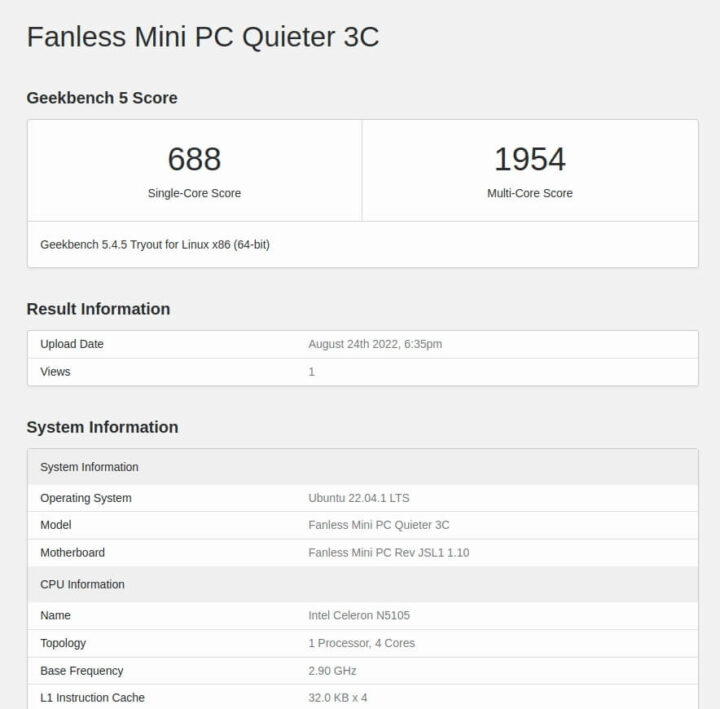
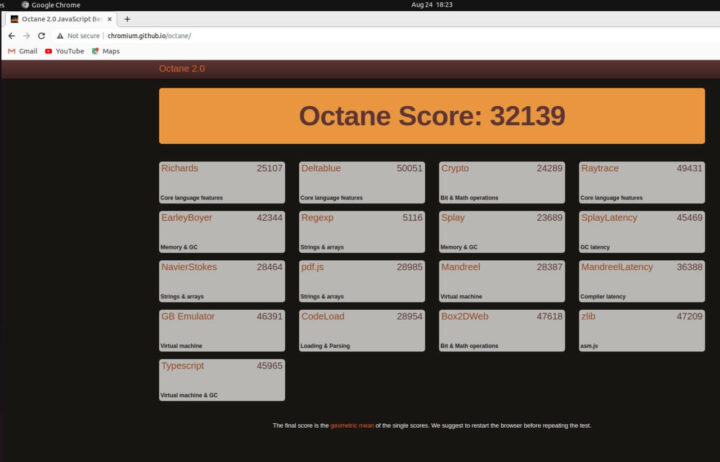
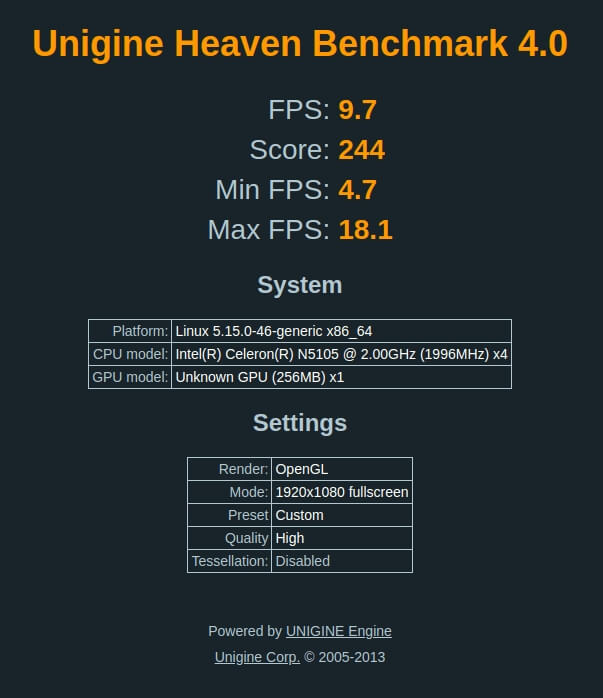
Linux 基准测试可以直接与使用 OpenGL 渲染在 Windows 中运行时进行比较:
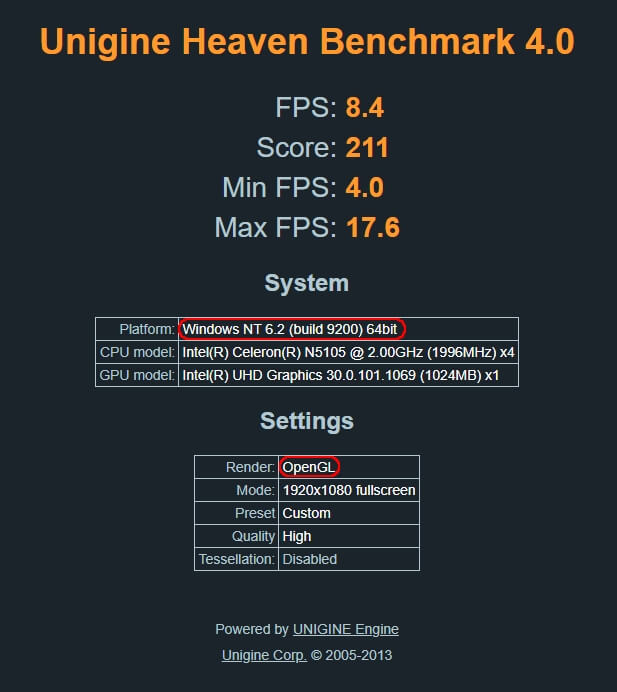
我还运行了 PassMark PerformanceTest Linux:
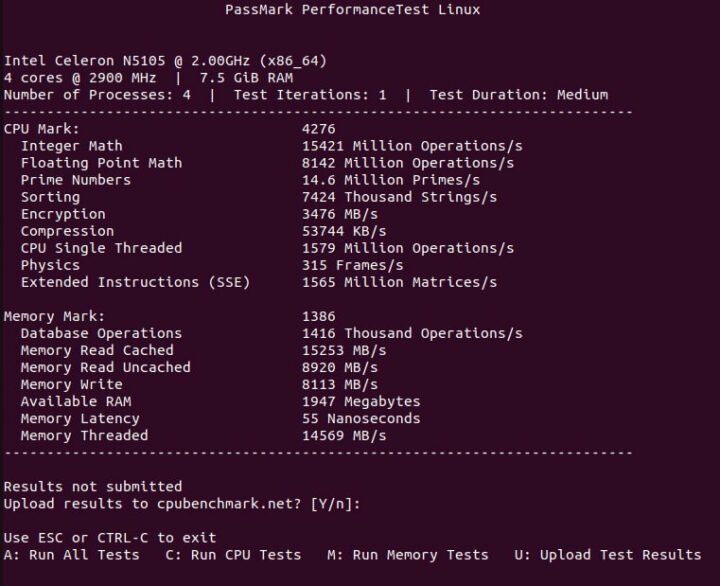
这里可以直接与在 Windows 上运行时的结果进行比较:
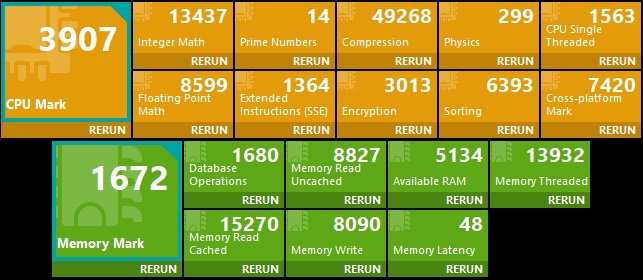
Ubuntu 的结果要比 Windows 的结果要稍微好些,查看电源配置文件时显示:在 Linux 下,“PL1”和“PL2”的值分别是 10 和 20 w,而在 Windows 下,它们只有 8 和 10 w:
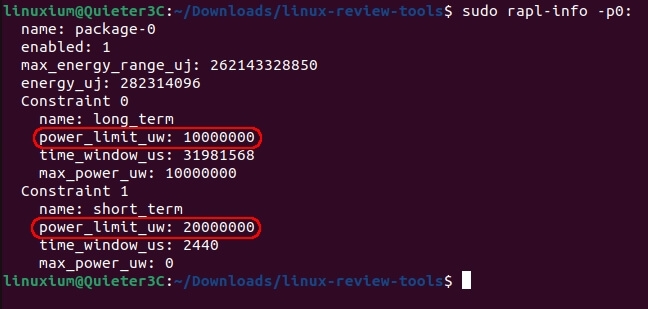
在网络浏览器中播放视频
实际测试时,我在 Windows 的 Edge、Chrome,以及 Ubuntu 的 Firefox 和 Chrome 中播放了一些视频。在 Edge 上,视频的初始编解码器是“av01”,但是因为它播放视频时很卡顿,所以它会自动切换到“vp09”,而 Chrome 则一直使用的是“vp09”,如下所示:
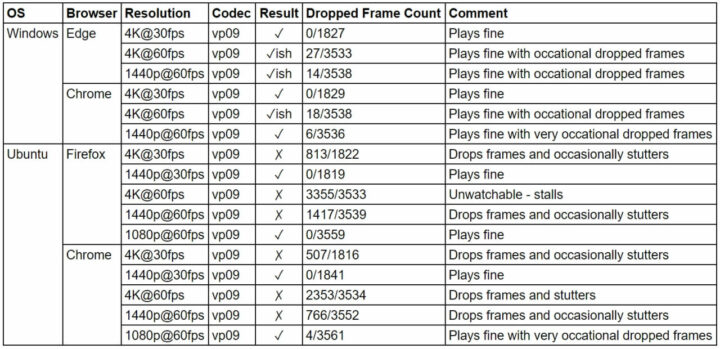
结果不出所料,Quieter3C 的表现与 Quieter3Q 还是十分相似的。
散热
在 Ubuntu 上运行压力测试时我发现其 CPU 温度迅速上升到了 58°C、然后又下降到了 50°C、接着又缓慢上升到了 66°C 的峰值温度,综合之后的最高平均温度是 63.9°C:
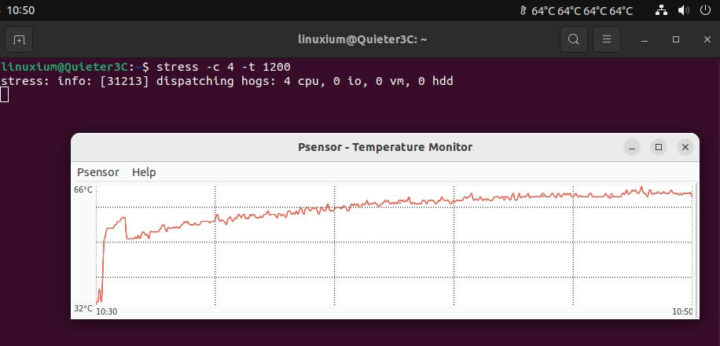
如果在压力测试期间监控 CPU 频率,我们可以看出初始温度峰值是由 CPU 在“PL1”持续时间内以平均 2600 MHz 运行而引起的,之后它会因为过热降频并下降到 2340 MHz 的平均频率上,这样可以防止过热:
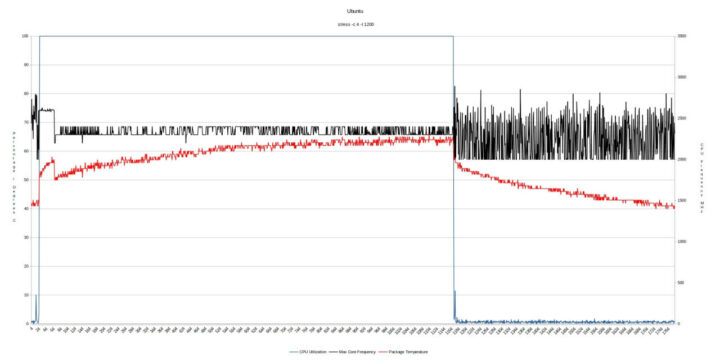
在压力测试期间,我在设备顶部记录的最高温度在 12.7°C 的环境室温下大约是 54.6°C,设备不至于太热而无法触摸。
MeLE 方面还表示,他们“通过在外壳上添加氧化铝导热板和硅垫可以改进散热结构”:
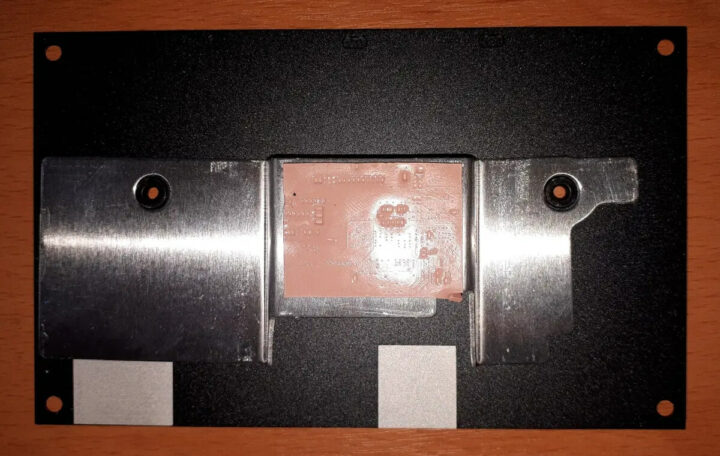
不过,在测试过程中,这其实也只是将设备顶部的温度从 Quieter3Q 上的 55.6°C 降低了1°,在 MeLE Quieter3C 上测量出来的温度是 54.6°C。我想在长时间使用的情况下,这项改动带来的效果可能会更加明显一些。
写在最后
此次的 MeLE Quieter3C 主要如下几个特点:一是将 Type-A USB 端口替换为了 Type-C USB 端口,而且通过这个改进 Quieter3C 实现了视频输出和电力传输;二是将其中一个 HDMI 端口换成了 mini DisplayPort ,这样可以简化某些用户的连接,不过对需要 HDMI 适配器的用户来说是一种阻碍。当然,作为被动冷却的迷你 PC ,它增加散热的额外内部金属板是一个受人欢迎的改进。
| 优点 | 限制 |
|---|---|
| 额外的 Type-C USB 功能 | 仅以 5 Gbps 运行 |
| 额外的迷你 DisplayPort | 移除一个 HDMI 端口 |
| 额外的内部热板 | 轻微的热改进 |
最后,十分感谢 MeLE 给我提供的 MeLE Quieter3C。如果你们感兴趣,可以在亚马逊上购买,我使用的 8GB/128GB 配置版的零售价大约是 270 美元。

文章翻译者:Nicholas,技术支持工程师、瑞科慧联(RAK)高级工程师,深耕嵌入式开发技术、物联网行业多年,拥有丰富的行业经验和新颖独到的眼光!


